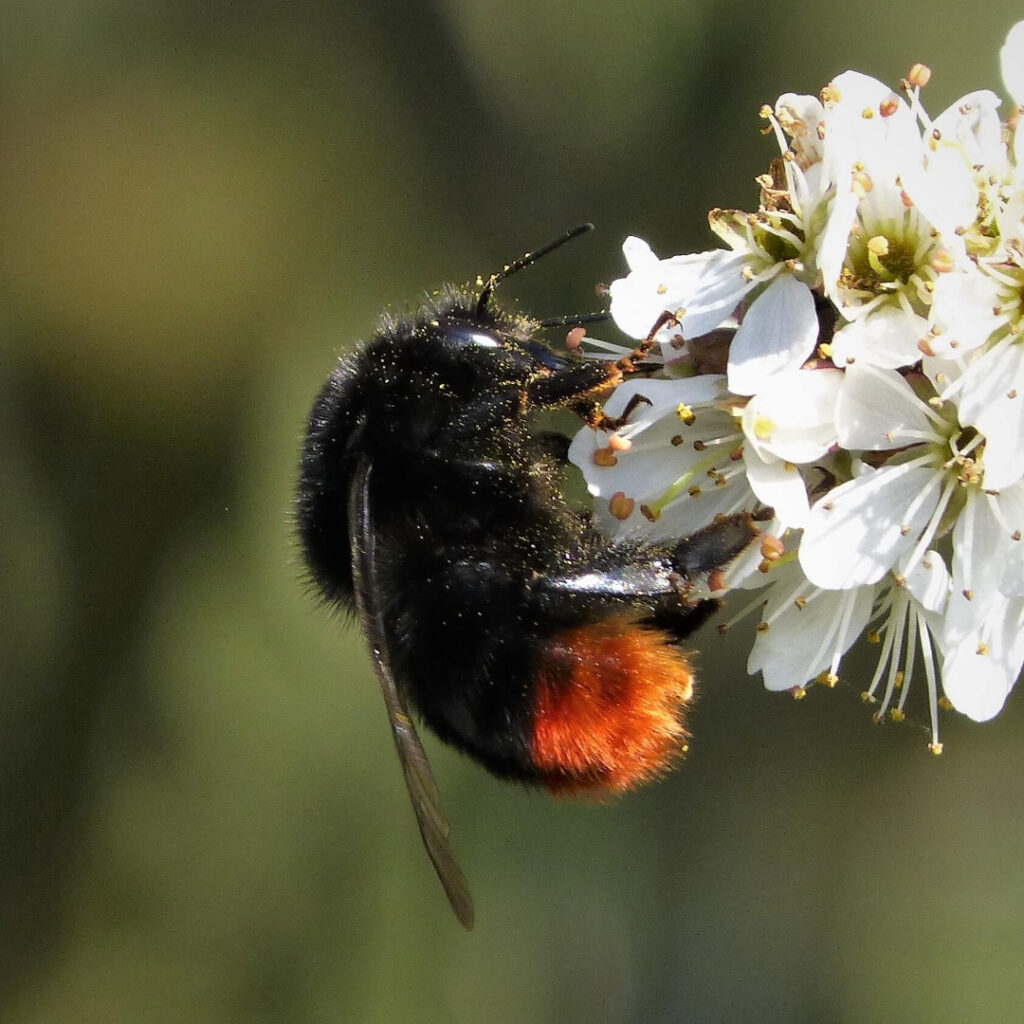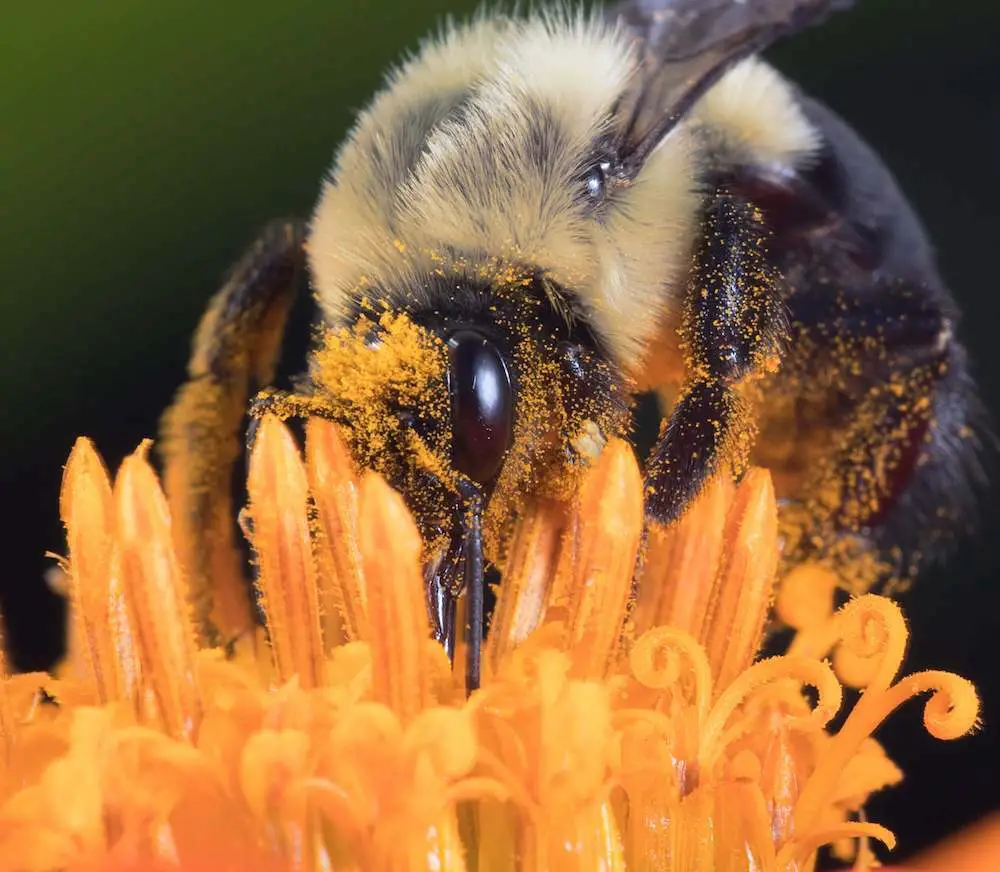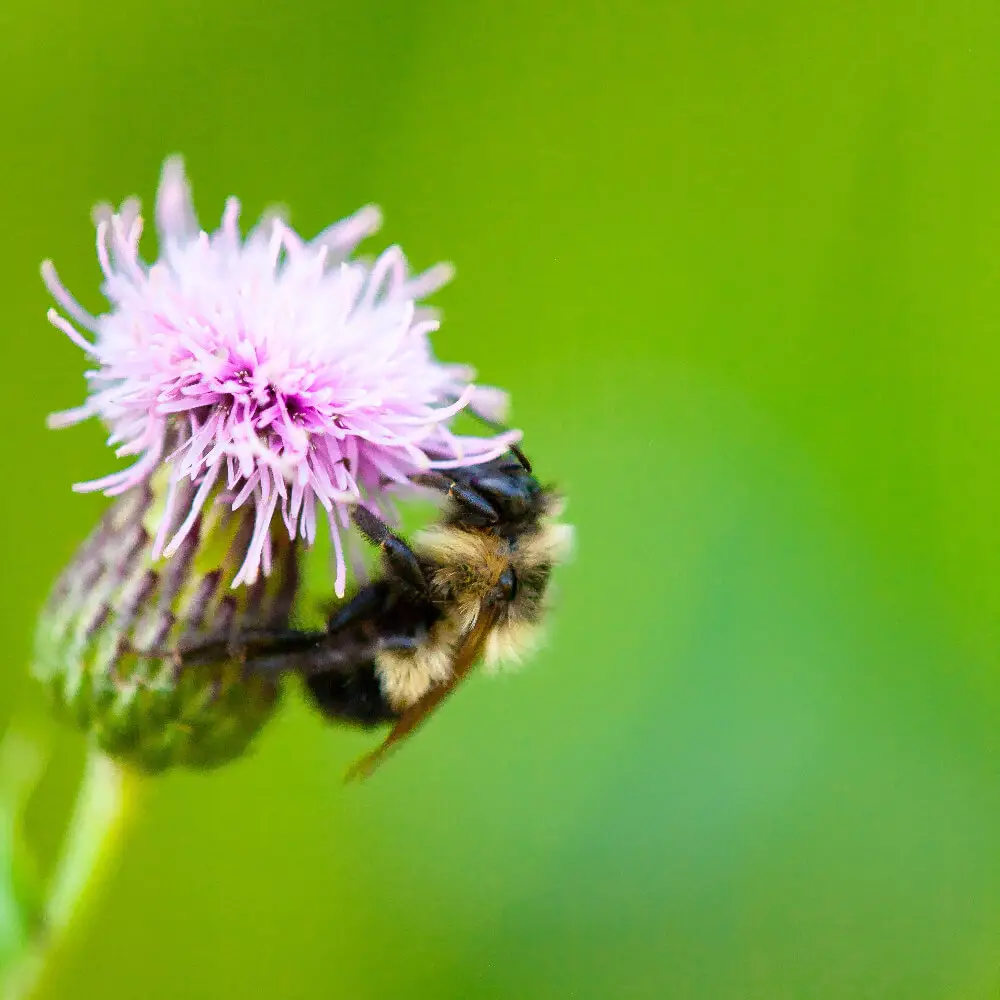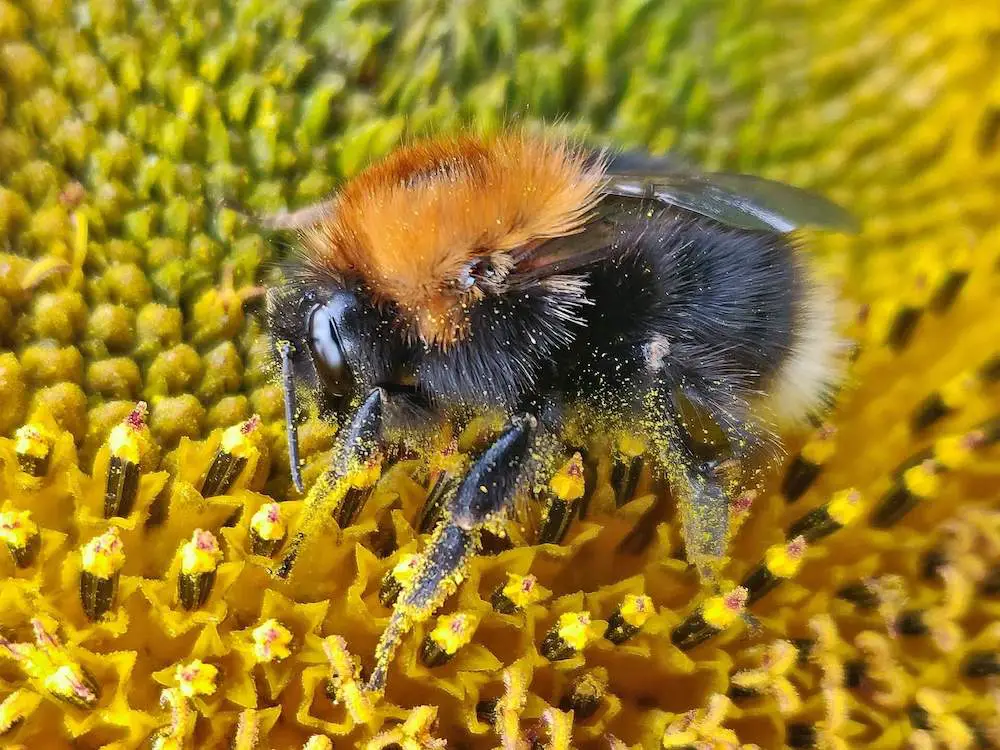Last updated on October 10th, 2023 at 03:49 pm
Ever wondered about that bumblebee with the striking red tail? Meet Bombus Lapidarius, commonly known as the Red-Tailed Bumblebee.
The buzzing world of bumbles is vast and varied, with over 20,000 known species but the Bombus Lapidarius stands out with its distinctive appearance and behaviour.
This buzzing beauty is more than just a pretty face; it plays a crucial role in pollination and has some fascinating behaviours. In this guide, we’ll delve deep into the life of this fascinating bee, helping you identify and appreciate its unique characteristics.
1. Appearance: What Does the Red-Tailed Bumblebee Look Like?
The Red-Tailed Bumblebee is a showstopper with its black body and vibrant red markings around the abdomen. The queen and worker females look similar, but the workers are noticeably smaller.
Males sport the red and black colouration but add a yellow band around the abdomen and yellow facial markings.
It’s worth noting that there are a number of different species that may have a red tail and these include the red-tailed cuckoo bee as well as some mining bees.
- Body: The Red-Tailed Bumblebee is a medium to large-sized insect. The queen, which is the largest, can measure up to 22mm.
- Colour: As the name suggests, it has a striking red or orange tail. The rest of its body is primarily black, with some older workers occasionally displaying a faded or worn appearance.
- Wings: Their wings are dark and slightly smoky in appearance.
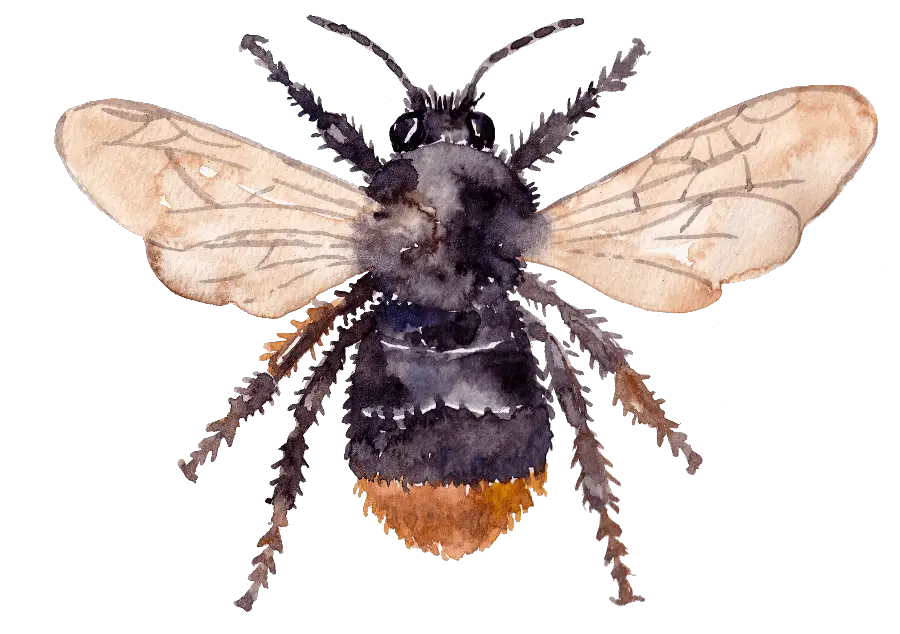
2. Habitat: Where Does the Red-Tailed Bumblebee Live?
These are globetrotters, found throughout Europe, including Britain, Ireland, parts of Greece, Germany, Sweden, and Finland. They prefer open terrains over heavily forested landscapes.
- Location: Widespread across Europe and parts of Asia. They’re particularly popular in the UK.
- Nesting: They prefer to nest underground, often in abandoned rodent burrows. Occasionally, they might choose tussocky grass or under stones.
- Environment: They thrive in various surroundings, including gardens, farmland, woodlands, and coastal areas.
3. Behavior: What Makes the Red-Tailed Bumblebee Unique?
- Social Structure: They live in colonies. A single colony can have up to 250 workers.
- Activity: They’re most active during the day and are known to be quite docile unless threatened.
- Pollination: Like other bumblebees, they play a crucial role in pollinating various plants, ensuring the survival of many ecosystems.
4. Diet: What Does the Red-Tailed Bumblebee Eat?
Pollen and nectar are their go-to foods. Sometimes, workers even try to munch on the queen’s eggs, but she’s not having any of that!
- Nectar: Their primary source of energy, they collect nectar from a variety of flowers.
- Pollen: Essential for feeding their larvae. They have a preference for flowers like daisies, thistles, and lavender.
| Favorite Flowers | Blooming Period |
|---|---|
| Daisies | Spring – Summer |
| Thistles | Summer |
| Lavender | Late Spring – Early Autumn |
5. Best Time to Spot Them
Summer is their time to shine! You’ll see Red-Tailed Bumblebees buzzing around in June, July, and August.
- Season: They’re most visible from early spring to late autumn.
- Time of Day: Your best chance to spot them is during the daytime, especially on sunny days when flowers are in full bloom.
6. Popularity and Distribution
- Europe: They’re one of the most common bumblebees in the UK and are widespread across Europe.
- Asia: Their presence extends to some parts of Asia, though they’re not as common as in Europe.
7. Reproduction, Social Structure and Behavior
In this section, we’ll discuss their reproduction and behaviour, focusing on the roles of males, females, and queens as well as their social interactions within the colony. They’re social creatures but don’t form extensive colonies. A typical nest contains only a few hundred. They don’t have a strict hierarchy among workers, but there’s a clear pecking order with the queen at the top.
- Colony Size: 100-200 workers
- Hierarchy: Queen > Workers
- Special Skills: Good at pollination due to medium-sized proboscis
Bumblebee colonies consist of different castes, including queens, female workers, and males. Queens are the reproductive females, who establish and control the colony. Female workers are sterile and have various duties such as foraging for pollen and nectar, caring for larvae, and defending the nest. Males, on the other hand, do not collect pollen and their main role is to mate.
They’re social bees, with colonies typically comprising a single queen, several hundred workers, and males. The colony’s lifecycle begins when a new queen emerges from hibernation in the spring, finds a suitable nest site and starts laying eggs. She will then continuously lay eggs throughout the season, producing both female workers and new queens.
Foraging is an essential behaviour for these bees, as they are important pollinators. Their long tongues allow them to access the nectar of various plant species. They also use their front legs to scrape pollen from flowers into their pollen baskets, located on their hind legs, which they carry back to the colony to feed the larvae and other members.
During the foraging season, they may come across cuckoo bumblebees, which are known for invading and taking over the colonies of other bumblebee species. The Red-Tails defend their colony from these invaders by aggressively patrolling the nest entrance and charging at intruders.
The Early Bumblebee is the smallest bee species in the UK and is closely related to the Red-Tailed. Both species are essential to the pollination of various plants and share some similarities, such as their social behaviour and the structure of their colonies.
Why Should We Care?
They’re critical pollinators. They’re especially good at pollinating plants like Viscaria, where only bees and butterflies have long enough proboscises to do the job effectively. Plus, they’re a part of the beautiful biodiversity we should strive to protect.
Species Classification
As enthusiasts of bumblebees, we are always eager to share our knowledge on different species, particularly the red-tailed bumblebees. A part of the Apidae family, red-tailed bumblebees are an interesting group with various species that can be identified by their distinctive black and red colouration.
Another species of interest is Bombus rupestris, sharing similar appearances to the red-tailed. However, its distribution is more limited, with its natural environment restricted to specific regions. Paying close attention to their physical traits, such as hair lengths and banding patterns, helps in distinguishing them from other red-tailed species.
Bombus ruderarius, known as the red-shanked carder bee, is another species within the red-tailed group. While they also exhibit the characteristic red tail, their bodies have additional distinguishing features, such as yellow hair bands on the thorax or sometimes an entirely yellow thorax.
Finally, we have the Bombus pratorum, the early bumblebee, which is known for its smaller size and short-haired body. This species is also a common sight in the UK and can be spotted visiting flowers during their active season.
In summary, red-tailed bumblebees are a diverse group within the Apidae family. Understanding the differences among bumblebee species is essential for appreciating their unique roles in pollination and nature.
Conservation and Threats
The story of bumblebees over the past century has been one of decline, including that of the Bombus Lapidarius. We are aware that two species became extinct in the UK during the 20th century, and the remaining ones face significant threats and pressures. It is essential to understand what we can do for their conservation and know the various challenges they face.
Red-tailed bees are very common and can be found in various surroundings across the UK, from gardens to farmland to woodland edges. They emerge early in the spring, feeding on flowers right through to the autumn, playing a crucial role in pollination. However, this species can be negatively affected by habitat loss, pesticide use, and climate change.
One of the challenges faced by the red-tails is the presence of the red-tailed cuckoo bee, which is a nest parasite that relies on the host’s resources and labour for its reproduction. This parasitic behaviour can have detrimental effects on the host species’ populations.
In our continued efforts to conserve these vital pollinators, the Bumblebee Conservation Trust encourages public participation in identifying bumblebee species and reporting sightings through online wildlife recording surveys like iRecord. Additionally, we support the North East Bee Hunt, which involves monitoring populations and environments over time to understand changes in distribution and population sizes.
Knowing that red-tailed bumblebees tend to nest underground and can have colonies with up to 300 workers active mainly in the spring and summer months, we can use this information to inform our conservation practices. By focusing our efforts on protecting vital habitats and raising awareness around the issues these bumblebees face, we all can play a part in safeguarding their future.
Conclusion
The Red-Tailed Bumblebee is not just another bee; it’s a fascinating creature with unique behaviours and crucial ecological roles. Next time you spot one, give it a nod of respect. And if you’re interested in helping these buzzing wonders, check out our revival kits.
The Red-Tailed Bumblebee is more than just a pretty face in the buzzing world. Its role in pollination is crucial for many ecosystems. By understanding and appreciating species like this, we can better appreciate the intricate web of life they support.
If you’re interested in identifying more species or learning how you can help in your area, check out our Identify Bees page for more information.
Remember, every species plays a vital role in our environment. By supporting initiatives like Revive a Bee, you’re not just helping one humble bumble, you’re contributing to the well-being of our entire planet and the pollinators that help ensure our survival.
Articles That Mention Red-Tailed Bumblebees
Britain’s Rarest Bee Spotted in Kent
Kent has become the recent hotspot for a rare bee sighting. The Fenn Bell Conservation…
Buzz Pollination: The Rock Concert of the Plant World
Buzz pollination might be a new term for you, but if you’ve relished blueberries, cranberries,…
The Different Types Of Bumblebee
There are approximately 250 different species of bumblebees across the world with varying sizes, colours…
Video of Red-Tailed Bumblebee Nest
Sources:
- Wikipedia
- Bumblebee Conservation
- Wildlife Trusts
- “Bombus Lapidarius” by gailhampshire is licensed under CC BY 2.0

